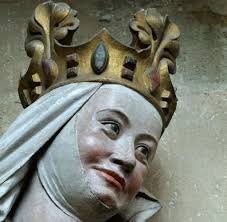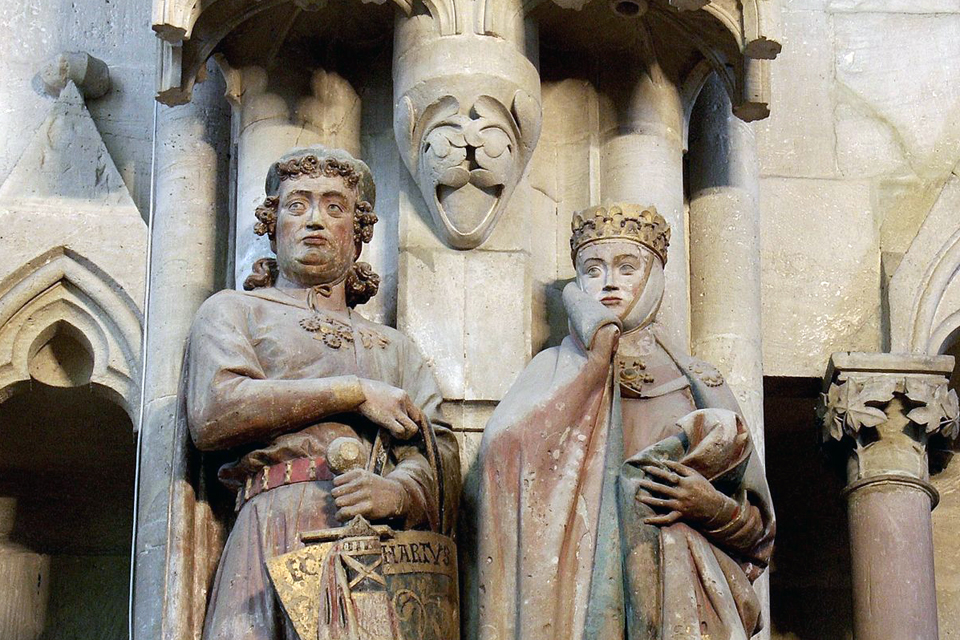The Naumburger Meister is renowned for his sculptures of the founders of the Naumburg Cathedral. as Individualised portraits, they surpass contemporary works of art.

This summer a magnificient exhibition in Naumburg in Germany showcases the works of one of the most outstanding Gothic sculptors and architects: The Naumburger Meister. We don’t know his name, nor much about his whereabouts; only rumours abound. However, untill now he was thought of as the epiphenomena of a “German Artist” – emotional, heartbreakingly romantic and authentic in every sense. So much so that his sculpture of one of the founders of the Naumburg Cathedral,Uta von Ballenstedt became the archetype of a German Nazi Hausfrau; and as a derivation of this, the prototype for evil queens, aka the evil stepmother of Snow White in Disneys film from 1937.
However, The Naumburg Master was not German, but French. In the German reviews of the current exhibition, this somewhat amusing detail is deemed one of the remarkable new results of the scholarship behind the show. By the way copiously published in a two volume catalogue covering every possible detail in 1568 pages.
According to this, The Naumburg Master likely learned his craft in northern France in the heyday of the High Gothic period. He seems to have been active in the towns of Noyon, Amiens, and Reims around 1225. Later he may have worked in Metz. Around 1230 he worked in Mainz on the Cathedral, where he created a fragmentary rood screen, which includes a famous sandstone relief of Saint Martin. This work of art was later as the Bassenheim Horseman.
Afterwards he traveled east along the Via Regia to Naumburg, where the reconstruction of a new cathedral had started around 1210 . Construction of the Gothic choir was likely finished by 1257, including the twelve monumental donor portraits that are considered his masterpieces. Made of Grillenburg Sandstone, some of the sculptures are identified by name while others cannot not be identified with certainty.
However, the Naumburg Master is also identified as the creator of the founder figures in the Meissen Cathedral and of the tomb slab of one knight Hermann von Hagen, the relative of a Naumburg canon, in Merseburg Cathedral. Thus, his art shaped the work of numerous sculptors all over Central Germany in the late Hohenstaufen period in the 13th century.
The Naumburger Meister’s world was undoubtedly neither German, nor French nor English, but belonged to an international artistic “school” operating on all levels; and thus discernible in the sculpture exhibited, but also in the stained glass paintings and illuminated manuscripts dating from this period, which are allowed to frame the master and his colourful work.
Undoubtedly, the sculptures in the Cathedral of Naumburg they were for instance painted in vivid cultures at the time of their launching. By now we are very well aquainted with the fact, that the white sculptures of antiquity was painted decorously. We tend, however, to forget that this was also the case with the sculptures in the Gothic Age. Recently – at the celebration of the 800 year of the Reims Cathedral – this was recreated in a typical French fashion. With “son et lumiere” it was shown how the sculptures of the facade may have looked originally. Here at the exhibition it is once again documented, that the Middle ages was far from bleak.
Much of this and much more is documented in detail at the exhibition, which really is “worth a detour” this summer.
In 2018, Naumburg became listed as UNESCO world Heritage
FEATURED PHOTO:
The portraits of the main benefactors Margrave Eckard II of Meissen and his consort Uta von Ballenstedt. Source Wikipedia
VISIT:
The Naumburg Master
Naumburg City
Germany
READ:




